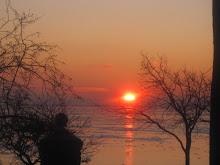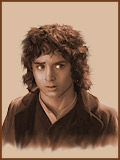
Here is the second part of my English essay.
Reflections on a Dark Age
As well as being greatly influenced by the First World War, J.R Tolkien was also affected by WWII, the rise of Communism and modernism and the breakdown of tradition. Although he himself did not fight in WWII two of his sons did. His concern for them is reflected in the characters of Frodo and Bilbo Baggins. As Frodo’s uncle, Bilbo, is very concerned about the peril his nephew is in. Bilbo tries to take on the quest himself at the council of Elrond but is not allowed to do so because of his age. (Tolkien, J.R.R. The Lord of the Rings. 50th Anniversary Edition. New York: Houghton Mifflin Company, 2004. Print.) Tolkien to, it seems, wished to take his sons places in the war as he wrote to his son Christopher, “ If only I could do something active.” (Croft, Janet. ""The Young perish and the Old Wither Lingering": J.R.R Tolkien on World War II." Mythlore June (2003): n. pag. Web. 11 May 2010. ) His opposition of communism is very strongly portrayed in the scouring of the shire, which happens at the end of the third book, Return of the King. While the war of the rings was being waged off in foreign lands Saruman the wizard was doing his best to industrialize the shire. He instituted community ownership of all produce and appointed some of his men to distribute it. The appointees kept the best produce for themselves and then sold much of it, earning a profit for themselves. Those who refused to cooperate were thrown in prisons where they were practically starved to death. Those who survived resembled inmates released from concentration camps.
J.R. Tolkien was saddened to see the decline of tradition in his lifetime. Having been raised in the country, he remembered those days as some of the best of his life. He shunned the hustle and bustle of the modern world and preferred a simple way of life. He never owned a car but instead rode his bike or walked wherever he could. (Collins, David. J.R.R Tolkien. First. Minneapolis: Lerner Publications Company, 2005. Print.) Tolkien’s villains are portrayed as destroyers of nature and all that is beautiful while his heroes love and protect it. ("J.R.R Tolkien and Nature." Tolkien-Online.com. Tolkien-Online.com, 2007. Web. 11 May 2010.) Tolkien’s villains also love machinery and seek to replace nature with it. Suraman manipulates nature by breeding orcs in a process similar to cloning. He chops down trees to build cities and factories that pollute the environment. Sauron kills all beautiful things in his realm and creates the mechanical monsters the Nazgul ride. (“National Geographic, Lord of the Rings, The Return of the King." National Geographic Society. National Geographic, 2009. Web. 4 May 2010).








No comments:
Post a Comment